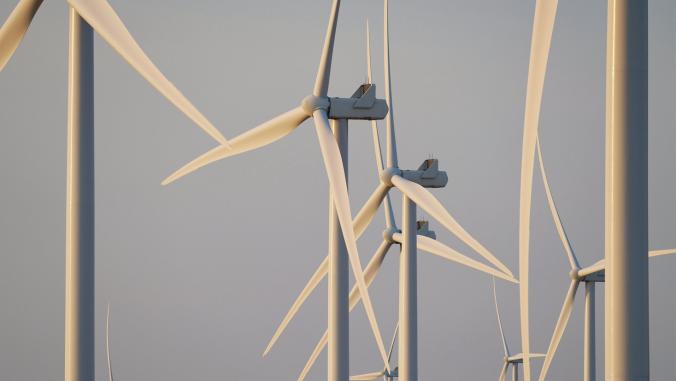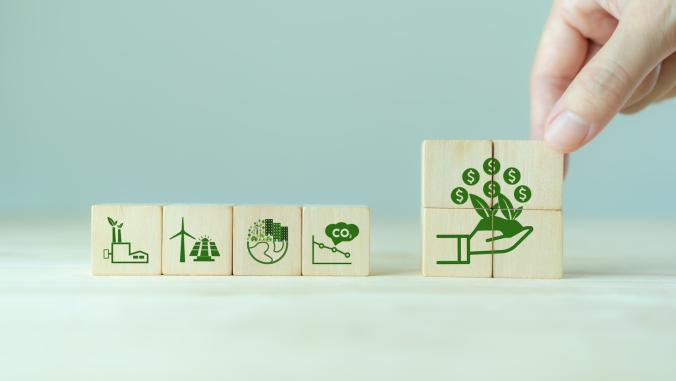The most noteworthy part of Apple’s 100% clean power milestone
Other big companies should emulate the tech giant’s focus on helping suppliers get there, too.

This week, Apple joined Google’s parent company Alphabet with the impressive proclamation that all of its global facilities — including its retail stores, data centers and that snazzy new headquarters in Cupertino, California — are powered by renewable energy.
As the company’s environmental chief, Lisa Jackson, observed Tuesday during the Bloomberg New Energy Finance conference, this is just the latest mile marker on a journey with a destination that will keep creeping forward as the company’s operations growth. "We don’t want to make too much out of it," she observed, describing the program as a "moving target."
Still, Apple was uncharacteristically detailed with the press release it issued describing its progress. One revelation that deserves particular attention: Close to two dozen of the company’s suppliers — ranging from components makers to leather designers — likewise have committed to operating on 100 percent renewable energy. They want to follow Apple’s example.
That’s nine additions since Apple’s September update on the program, which it launched back in 2015 to address the huge carbon footprint associated with its vast supply chain. Last year, the clean electricity generated by projects undertaken by its suppliers helped offset 1.5 million metric tons of greenhouse gas. That’s the equivalent of keeping 300,000 cars powered by internal combustion engines in the garage.
The list of new suppliers includes biopolymer and plastics makers Arkema and DSM Engineering, soft goods manufacturer ECCO Leather, optical components company Finisar, accessories company Luxshare-ICT, iPhone manufacturer Pegatron, magnetic parts maker Quadrant, key Mac partner Quadrant Computer and components partner Taiyo Ink.
Participation in the program is voluntary, but Jackson suggests it hasn’t been that difficult to convince partners to listen. While 23 companies have made formal commitments, more than 85 have signed up for Apple’s Clean Energy Portal, a site that the company created in order to help its suppliers investigate options within their region. "They have a belief that it’s necessary, and they know this isn’t a charitable project," Jackson said.
That said, Apple has been proactive in stepping up with resources to help meet what Jackson describes as a "tough new spec" for companies interested in being part of Apple’s network. “We help them find the right deals, the ones that will be meaningful on their grid,” she said.

Apple’s team is lending its voice to policy discussions in several regions where support for solar and wind projects is either nascent or evolving, including Japan, Vietnam, India and China. It has helped local developers make arrangements for onsite installations, and it helped one particularly big partner, Jabil, negotiate a relatively rare wind power purchase agreement to cover Chinese facilities in Wuxi, Chengdu and Huizhou. So far, Apple has been involved with the development of more than 485 megawatts of solar and wind in six provinces.
"If you don’t have it, you invent it," Jackson said.
To be clear, none of these all-in commitments are time-bound and many are starting with energy efficiency improvements. But Jackson said the company hopes to inspire additional of 4 gigawatts of clean energy to the local grids supporting its supply chain by 2020 — that’s about 30 percent of all manufacturing emissions. So far, it has helped motivate additions of around 3 gigawatts.
For perspective, Apple’s focus on its own internal operations has resulted in 25 operational renewable energy projects around the world — with a generation capacity of 626 MW. It has 15 more projects under construction, which will more than double that amount. Jackson estimated the company’s electricity consumption (not including its supply chain) at 1.8 billion kilowatt-hours annually.
Since 2014, Apple has reduced the carbon emissions from its own facilities by 54 percent, or about 2.1 million metric tons of carbon dioxide. But it figures that around 77 percent of its carbon footprint lies its manufacturing value chain, thus the interest in inspiring action by its suppliers.
Apple prioritizes clean power installations that add electricity directly to the local grid where its operations are based. For example, its new HQ includes a 17-MW rooftop solar array and 4 MWs of biogas fuel cells that are integrated with battery storage. It has negotiated PPAs to cover the 25 percent of the time when these technologies can’t cover the site’s power needs, Jackson said.
If an onsite investment doesn’t make sense, Apple seeks to be "materially involved" in the development of new solar and wind generation resources. That was the strategy behind development partnerships in Nevada and North Carolina, as well as a 200-MW PPA for a wind farm in Oregon.
Buying renewable energy certificates is Apple’s strategy of last resort. "And when we do, we stay true to the regional grid," Jackson said.
Apple isn’t interested in making money off its clean power projects, but it also won’t settle for paying premiums that don’t make sense. "We bring reality into the conversation," she noted.
"Apple is known for doing things that people say can’t be done."
Apple’s program to help suppliers increase their clean energy consumption is still unique, but such initiatives will be imperative for companies that have set 100 percent renewable energy goals, according to a guide (PDF) published in November by the Climate Group. Aside from Apple, the two companies that have made the most progress are furniture maker IKEA, reworking its program after a slow start in 2014, and British Telecom, which has started building emissions-reduction clauses into its supplier contracts.





